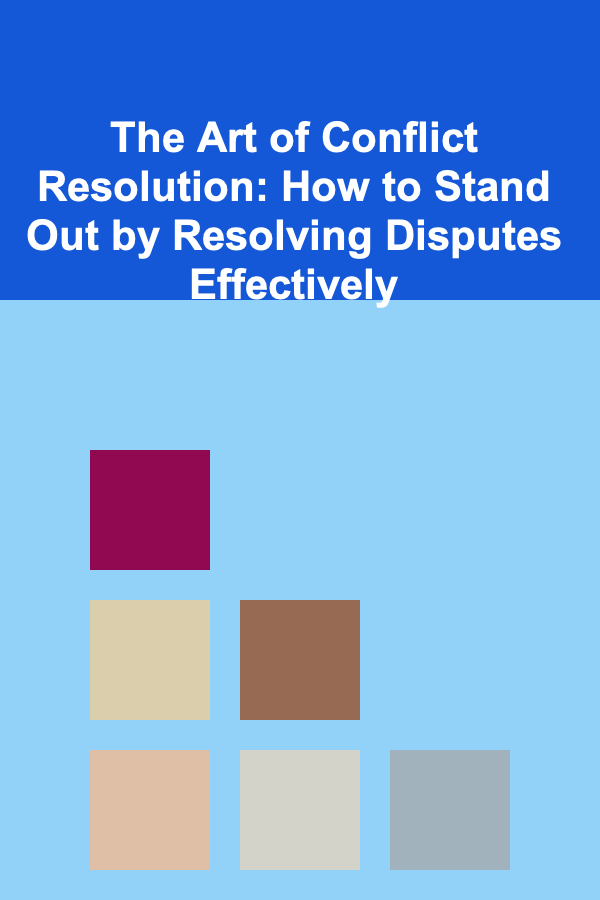
The Art of Conflict Resolution: How to Stand Out by Resolving Disputes Effectively
ebook include PDF & Audio bundle (Micro Guide)
$12.99$8.99
Limited Time Offer! Order within the next:

Conflict is an inevitable part of life---whether in personal relationships, workplaces, or within communities. How you handle these conflicts can define you as a leader, a colleague, or even as a friend. Effective conflict resolution doesn't just resolve the issue at hand; it strengthens relationships, promotes mutual respect, and fosters a collaborative atmosphere. The ability to navigate and resolve disputes is a skill that can set you apart from others, establishing you as a respected figure in any environment.
This actionable guide will explore how to resolve conflicts effectively, providing you with strategies and techniques that will not only help you manage disputes but also turn them into opportunities for growth and stronger connections.
Understanding Conflict
Before diving into resolution techniques, it's essential to understand what conflict is and why it occurs. Conflict arises when individuals or groups have differing needs, values, or perspectives. It's natural for people to disagree, but it's how those disagreements are managed that matters.
Why Conflict Happens
Conflicts arise from several core reasons:
- Miscommunication -- Often, conflicts stem from a lack of understanding or misinterpretation of another person's words, intentions, or behavior.
- Differing Values or Needs -- When people hold different values or needs, they are more likely to experience conflict. This can occur in a personal setting or within a professional environment.
- Personality Clashes -- Different personalities can lead to misunderstandings or disputes. For instance, an assertive individual might clash with someone more passive.
- Resource Scarcity -- In situations where resources like time, money, or attention are limited, competition for those resources can lead to conflicts.
Understanding the root causes of conflict will guide you in choosing the right approach to resolve it effectively.
Step 1: Cultivate Emotional Intelligence
Before addressing the conflict itself, it's essential to develop emotional intelligence (EQ). Emotional intelligence is the ability to recognize and manage your own emotions, as well as the emotions of others. People with high emotional intelligence are often better equipped to navigate difficult situations, as they remain calm under pressure and can empathize with others' feelings.
Key Components of Emotional Intelligence:
- Self-Awareness -- Understanding your own emotions and how they affect your thoughts and behaviors.
- Self-Regulation -- Managing your emotions in healthy ways, especially when under stress or anger.
- Empathy -- Understanding and being sensitive to the feelings, thoughts, and perspectives of others.
- Social Skills -- Building rapport, maintaining relationships, and resolving conflicts effectively.
By improving your emotional intelligence, you will be better equipped to handle conflicts calmly and constructively.
Step 2: Actively Listen to All Parties Involved
One of the most critical steps in resolving any conflict is active listening. When individuals are in conflict, they often feel unheard or misunderstood. By listening attentively, you convey that everyone's opinion matters and that you value their perspective.
How to Listen Actively:
- Give Full Attention: Put aside distractions and give the person your undivided attention. This shows respect for their feelings and opinions.
- Avoid Interrupting: Let the person speak without interruption, as interrupting can create frustration and escalate the conflict.
- Clarify and Paraphrase: Repeat back what the person has said in your own words to ensure understanding. For example, "So, what I'm hearing is that you feel frustrated because..."
- Ask Open-Ended Questions: Encourage the person to express their thoughts fully by asking questions like, "Can you tell me more about how this situation made you feel?"
Active listening helps de-escalate tension and builds trust, setting the stage for a more productive resolution.
Step 3: Stay Neutral and Avoid Taking Sides
In any conflict, it's essential to remain neutral. Taking sides can escalate the situation, make the parties feel like their concerns are not being addressed, and worsen the dispute. By staying neutral, you position yourself as an impartial mediator who's focused on resolving the issue rather than contributing to it.
How to Stay Neutral:
- Acknowledge Emotions, Not Just Facts: Validate the emotions of each party involved, regardless of whether you agree with their viewpoint. For example, "I understand why this situation would make you feel upset."
- Use Neutral Language: Avoid using language that could be seen as judgmental or accusatory. For example, instead of saying "You always act this way," try "It seems like this behavior has been a concern for both of you."
- Stay Focused on Solutions: Keep the conversation centered on resolving the issue, rather than focusing on past grievances.
By maintaining neutrality, you establish trust and respect among all parties involved, allowing you to be seen as a fair and effective mediator.
Step 4: Find Common Ground
The next step in conflict resolution is to identify common ground. Even in the most contentious situations, there are usually shared values, goals, or interests that can serve as the basis for compromise and collaboration. Identifying these points of agreement helps build rapport and demonstrates that both sides can cooperate for mutual benefit.
How to Find Common Ground:
- Focus on Shared Goals: Bring attention to the larger objectives that everyone can agree on. For instance, if two colleagues are in conflict over the direction of a project, remind them that their shared goal is the success of the project.
- Look for Small Wins: Even if you can't resolve the entire conflict immediately, find small areas where both sides can agree. This helps build momentum for the resolution process.
- Emphasize Collaboration: Encourage both parties to work together toward a solution rather than continuing to argue over their differences.
By finding common ground, you foster an environment of collaboration, which is essential for effective conflict resolution.
Step 5: Encourage Constructive Communication
Many conflicts arise from poor communication, whether it's a lack of clarity, tone, or delivery. Encouraging constructive communication can prevent misunderstandings and help both sides express their feelings in a way that promotes understanding rather than further conflict.
How to Encourage Constructive Communication:
- Use "I" Statements: Encourage participants to use "I" statements to express their feelings without blaming the other party. For example, "I felt frustrated when the meeting was postponed without notice," instead of "You always cancel meetings at the last minute."
- Be Respectful: Emphasize the importance of respect in communication. Avoid name-calling, insults, or inflammatory language.
- Stay Calm and Focused: Keep the tone of the conversation calm and focused on the issue at hand. If emotions run high, take a break and return to the conversation when both parties are calm.
Constructive communication allows both sides to express their concerns and feelings openly, paving the way for resolution.
Step 6: Collaborate to Find a Solution
The most effective conflicts are resolved not by one side "winning," but by finding a solution that works for everyone involved. Collaboration is key to achieving a solution that meets the needs of all parties and helps move forward in a positive direction.
How to Collaborate Effectively:
- Brainstorm Solutions: Encourage both sides to suggest potential solutions. By involving everyone in the process, you increase buy-in and ensure that the solution addresses all concerns.
- Evaluate Options Together: Discuss the pros and cons of each potential solution. Be open to compromise and creativity in finding a solution that works for everyone.
- Agree on Action Steps: Once a solution has been identified, ensure that both parties are clear on the action steps and responsibilities moving forward.
Collaboration ensures that both parties feel heard and that the resolution is mutually beneficial, fostering long-term positive relationships.
Step 7: Follow Up and Provide Support
After a resolution is reached, the work doesn't stop there. It's essential to follow up to ensure that the solution is working and that no new issues have emerged. Providing ongoing support helps maintain the resolution and prevents future conflicts from arising.
How to Follow Up:
- Set Check-Ins: Schedule follow-up meetings or discussions to ensure that both parties are satisfied with the resolution and that no new issues have arisen.
- Offer Continued Support: Make sure that both parties have the resources or assistance they need to implement the agreed-upon solution.
- Be Open to Adjustments: Be willing to adjust the solution if necessary, based on feedback from those involved.
Following up shows that you are committed to maintaining a positive resolution and that you value the well-being of all parties.
Conclusion: The Power of Conflict Resolution
Mastering the art of conflict resolution is an essential skill for building strong relationships, fostering teamwork, and creating positive environments in both personal and professional settings. By cultivating emotional intelligence, practicing active listening, staying neutral, finding common ground, encouraging constructive communication, collaborating on solutions, and following up, you can transform conflicts into opportunities for growth and connection.
Being an effective conflict resolver not only enhances your reputation but also strengthens the community or organization around you. Conflict doesn't have to be destructive; with the right mindset and strategies, it can be a powerful catalyst for positive change.

How to Build an Emergency Fund and Why It's Important
Read More
How to Build Wealth Through Compound Interest Investments
Read More
How to Create a Cozy Fire Pit Area with Limited Space
Read More
How to Provide Constructive Feedback on Student Videos
Read More
How to Start a Dance Studio
Read More
How to Use Lighting to Enhance Your Home Staging
Read MoreOther Products

How to Build an Emergency Fund and Why It's Important
Read More
How to Build Wealth Through Compound Interest Investments
Read More
How to Create a Cozy Fire Pit Area with Limited Space
Read More
How to Provide Constructive Feedback on Student Videos
Read More
How to Start a Dance Studio
Read More